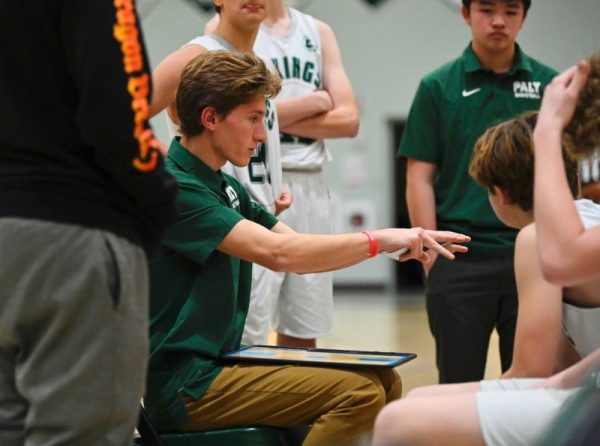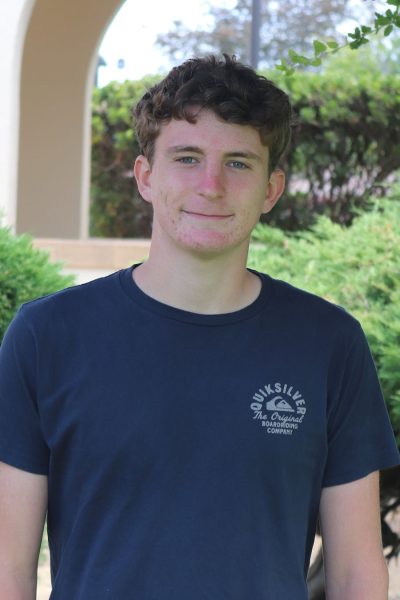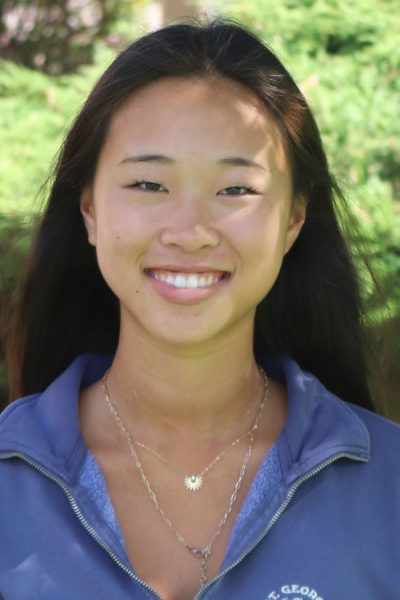 At Paly, several coaches also juggle other jobs, leveraging skills from their outside jobs to enhance their coaching. Their passion and commitment significantly impacts students’ lives, yet often go unrecognized.
At Paly, several coaches also juggle other jobs, leveraging skills from their outside jobs to enhance their coaching. Their passion and commitment significantly impacts students’ lives, yet often go unrecognized.
With Paly sports, the spotlight is generally focused solely on the student-athlete. Parents are present at games to see their kids play. Students go to support their friends. Others attend simply to spectate a sport they love. When the clock strikes zero, fans remember the highlights: a beautiful goal, an incredible interception, a powerful homerun. Rarely, however, is a coach’s strategy, leadership, or dedication mentioned: the countless hours they commit to creating gameplans, leading practice, and providing feedback is almost always overlooked. Yet a coach’s influence is not only measured by team success; they are role models dedicated to helping students succeed both on and off the field.
Brandon Byer, who coaches JV basketball and is an assistant coach for Varsity basketball, loves being able to make a positive impact on student’s lives through his passion for athletics.
“What motivates me is my passion for assisting our youth and doing so through physical activity or sport,” Byer said. “I really embrace the roles that I have as a coach which enables me to teach life skills through skill advancement, knowledge, and character development.”
Although coaches receive compensation for their time, a high school coach cannot live sustainably off of their coaching salary. Instead, they often coach alongside a full-time job. These dedicated individuals spend their days working in various professions, only to head straight to practice afterward. It is a lifestyle that requires impressive time management skills and a genuine passion for supporting young athletes.
Coaching at Paly is more than just a side job for these committed people. For many, it feels like they’re adding a second full-time job on top of their main one.
John Suter, who manages two airports while coaching JV baseball, embodies this relentless lifestyle.
“Working and running two airports and then coaching baseball six months out of the year presents quite a challenge,” Suter said. “I have 24 hours in a day, and it’s a constant grind. I draw strength from the lessons I learned growing up about the importance of a good work ethic.”
From early mornings spent preparing lessons or going to work, to late nights on the field or court, these coaches are not wasting a second of their time. Whether it be 5:45 a.m. daily morning practices or late games, it is these coaches who prioritize their athletes and consistently show up.
Jon Kessler, w ho teaches during the day at Addison Elementary School and coaches the decorated Paly wrestling team in the afternoons, feels that the two roles are often interconnected, but still require a careful balance.
ho teaches during the day at Addison Elementary School and coaches the decorated Paly wrestling team in the afternoons, feels that the two roles are often interconnected, but still require a careful balance.
“I balance by just making sure to stay on top of all my duties as a coach and teacher. I’m always planning in advance to make sure I don’t fall behind,” Kessler said. “Thankfully, teaching and coaching go hand in hand, my teaching job ends at 3 p.m., and then I head over to Paly around 4 p.m. to start practice. It’s a bit of a grind, but I enjoy it.”
Clare Doyle, the Paly girls field hockey coach and predoctoral researcher for an economics professor at Stanford’s Graduate School of Business, focuses on the research on corporate taxation.
“I am using IRS data to identify corporations that set up specific international affiliate structures to legally avoid US taxes, and examining the economic impacts of these structures.” Doyle said.
As a graduate student at Stanford, Doyle finds herself very busy in school, but finds ways to be flexible around her busy schedule. This allows her to be able to be available for her student-athletes.
“Working in academia affords me a lot of flexibility to set my hours, and luckily Stanford is really close to Paly,” Doyle said. “Usually, I use coaching as a break in my workday and then go back to campus after practice to get a few more hours in.”
Doyle’s focus on being flexible shows her athletes how important it is to find balance in life. Similarly to these coaches managing multiple jobs, Paly athletes have to balance their schoolwork with sports. Being a student, especially at Paly, puts pressure on student athletes, as they are expected to excel in both academics and athletics. Seeing Doyle’s dedication encourages her student-athletes to ha ndle their own busy schedules. Balancing a coaching role with outside jobs is more than just managing time—it’s about staying fully engaged, even when you’re exhausted from constantly shifting between responsibilities. Brandon Byer teaches his P.E. lessons before coaching basketball at Paly. He talks about the importance of keeping his energy up in both settings.
ndle their own busy schedules. Balancing a coaching role with outside jobs is more than just managing time—it’s about staying fully engaged, even when you’re exhausted from constantly shifting between responsibilities. Brandon Byer teaches his P.E. lessons before coaching basketball at Paly. He talks about the importance of keeping his energy up in both settings.
“I juggle both teaching and coaching by being present in the moment and always trying to bring the same type of energy no matter where I am,” Byer said. “At school, I focus on our students and teach classes with high energy and passion. On the basketball court, I transfer that same fervor toward our high school student-athletes.”
Coaches like Suter, Kessler, and Byer take on two jobs for one big reason– because they love helping young people. However, it is a commitment that comes with great sacrifices. Balancing both roles means they often have little room for personal hobbies, relaxation, and rest. Many coaches like Suter have strategies for finding calm in the chaos.
“When things, ideas, and even people become overwhelming, I stop to take a moment and return to my breathing,” Suter said. “Slowing down the moment and remembe
ring that I am just passing through history.” Despite the intense schedule, coaches like Kessler and Byer find ways to carve out moments for themselves to avoid burnout. Although Byer and Kessler have similar circumstances, they have different strategies to help decompress.
Despite the intense schedule, coaches like Kessler and Byer find ways to carve out moments for themselves to avoid burnout. Although Byer and Kessler have similar circumstances, they have different strategies to help decompress.
Kessler relies on his assistant coaches to help share the workload.
“I have great assistant coaches who put in a ton of time with the program,” Kessler said. “I can count on them to help run things if I’m busy. I also help to manage both by making sure I have some time to myself whether it’s playing golf, meeting up with friends, or spending time with family.”
Byer, on the other hand, makes it a point to set aside time for exercise, meditation, and reading.
“It’s imperative that I maintain quality physical fitness, eat healthy, sleep, and take time for myself in certain passions that I enjoy,” Byer said. “If I don’t do this, burnout is almost assured.”
Despite the pressures and the long hours that come with balancing coaching alongside a stressful outside job, the rewards of coaching are what keep these individuals going. Kessler explains that there is no better feeling than watching their athletes develop on the field and in life.
“It’s rewarding when you see hard work paying off,” Kessler said. “It’s rewarding when the athletes trust the process and believe in their teammates and coaches. It’s rewarding when going to work and getting asked how the wrestling team did at the tournament over the weekend.”
Similarly, Suter and Doyle both find joy in watching their players develop confidence and resilience.
“Watching a player gain confidence from putting in the work and believing in the process fills me with a deep sense of joy,” Suter said.
“It is incredibly rewarding getting to see players’ hard work pay off on the field, and to watch them grow as leaders as well as athletes,” Doyle said. “Field hockey is not as big in California as it is on the East Coast (where I moved from), and I really love getting to give back to the game and helping the sport grow and thrive out here.”
Another reason for being a dual-role coach is knowing that you are making an important impact on the younger generations’ lives and helping form a better future for the world.
“There are few things that gi

ve me more energy and excitement than when winter arrives and basketball season truly begins,” Byer said. “It is at that time of year when I know that my passion for teaching and coaching merge together. The responsibility of being able to teach and coach means everything to me.”
One of the unique benefits of coaches working other jobs is the skills they bring from one role to the other. Skills such as problem-solving, communication, and leadership, make them better coaches and give their respective teams an advantage. The problem-solving, communication, and leadership skills honed in their day jobs often enhance their coaching abilities, providing extra benefits to their teams. Byer believes his roles as a teacher and coach complement each other.
“As a teacher and a coach, communication is critical,” Byer said. “The lessons, concepts, and life skills I teach in the classroom are also shared with our Paly athletes, though I may present them differently on the court.”

Similarly, Doyle finds that balancing both jobs comes with benefits that help improve her daily life.
“One of my favorite things about holding both jobs is that they are incredibly different from each other. Getting to spend a couple hours in the sunshine every afternoon after sitting at a computer coding all morning is one of the biggest perks of coaching,” Doyle said.
Despite the differences, she acknowledges that both jobs need strong communication and organizational skills.
“Both coaching a team and writing a research paper involve a lot of moving pieces, and neither can be done by one person working alone,” Doyle said.
The impact these coaches have goes beyond wins and losses. They are teaching life lessons to their athletes that go beyond the classroom or the playing field. They are the first ones that students turn to for help in almost anything. This mentorship helps them not just with their sports careers, but with their lives as well.
“I think any coach will also tell you that we are just as competitive and invested in the season as our players are, often even more,” Coach Doyle said. “Practices and games are always a strong motivation to help get through the rest of my workday.”
Even though these coaches do so much for their students, the contributions of dual-role coaches often are not talked about. They aren’t recognized half as much as the athletes are, even though the coaches are the ones putting them out on the field. The hours they spend planning and preparing are not seen by most people. Their dedication to balancing two jobs is rarely acknowledged, but it is this commitment that makes them so invaluable. “Whatever you do will be insignificant, but it’s important that you do it,” Coach Suter said. The quiet dedication of coaches who work hard highlights their genuine desire to make a difference in the younger generation.
High school coaches with other jobs are the unnoticed heroes of the Paly Athletics community. They bring dedication, skill, and commitment to their roles, and their impact goes far beyond sports. These coaches not only help athletes advance in their athletics, but also teach resilience, perseverance, and the value of showing up no matter what.
By juggling their coaching duties with their careers, they show each student-athlete what a good work ethic looks like. Every one of these coaches deserves more recognition for their sacrifices and the big difference they make in their students’ lives, serving not just as coaches, but as role models.






